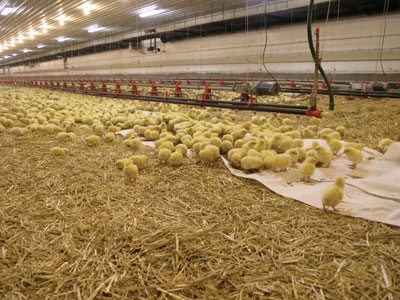
Hands-on Brooding Gets Results
By Dan Woolley
Features Breeders Production Poultry ProductionTime in the barn and attention to detail are essential
 Close attention to brooding management is key to achieving production performance.
Close attention to brooding management is key to achieving production performance. Close attention to brooding management is essential according to Dr. Scott Gillingham, DVM, Canadian Regional Business Manager for Aviagen, Inc.
He told registrants at the Atlantic Poultry Conference in Wolfville, N.S., the first 10 days in the broiler barn are crucial to bird health and ultimate profitability.
Today’s broilers grow bigger, faster, observed Gillingham. “They are putting down a lot more protein. They are more aggressive to feed.”
Rapid weight gain in young broilers presents management challenges to the poultry farmer. “There is no room for error. They grow right before your eyes,” he said.
Farmers must look to their stockmanship and the young broilers’ genetics, nutrition and health.
He insisted: “You have to be in the barn to observe the birds when they are eating, sleeping or drinking in order to achieve a steady state in brood management.”
Feed
With today’s broilers, good management is critical, stressed Gillingham. “We need to measure the birds’ production performance. Feed them as soon as they arrive in the barn…stimulate their guts. Get them on feed, not on litter.”
If the chicks’ development is delayed they will not catch up, he said. “Any delay means a big loss at the back end.”
“Watch your birds’ behaviours. Put their feeders close to their comfort zone under their heaters.”
Production, he continued, is derived from their daily nutrient intake. “Where is the feed? Can they get to it? Supplemental feeders must be accessible.”
Birds also have a preference for a certain pellet size, observed Gillingham, not powder or big chunks of corn. “Look at getting birds off crumbs and onto pellets.”
With “fine feed they will spend more time at the feeder. That is why you want to get to pellets sooner.”
The poultry producer should establish the chicks’ comfort zone within their first 10 days in the barn, he said, observing that too much heat will destroy their guts. Moreover, their state of hydration should also be checked. But, with a comfortable brooding temperature, the chicks will grow.
A lot of feed conversion can be lost in the first 10 days and variations in humidity will influence the effective temperature for the birds, said Gillingham.
Crop Fill
Gillingham added: “Crop filling is the best thing you can do in the barn. Check it along with bird temperature. It is critical.” The crops should be at least 85-per cent filled within their first 12 hours in the barn, he stated, adding barn temperature will affect crop filling.
Light intensity in the barn, at 50 to 70 lux, is also critical in the birds’ first seven days in the barn. Gillingham said some poultry barns are only 20 lux.
“Paint the barn interior white,” he suggested. “We need the birds to see their environment to feed and drink.”
The lighting program for brooder management must be tailored to the birds’ sex, targeted weight and feeding programs, he said.
Drinkers
As for the birds’ water requirements, there are peak demand periods in the barn, so there must also be a source of immediate, clean water, Gillingham said. In addition, the producer must check the flow rates of his water system’s nipples, which in the first week in the barn should be at least 25 millilitres. of water per nipple. “You have to have consistency. A reduced flow rate reduces growth,” he said.
To view videos on crop fill, barn temperature and how to weigh chicks, go to www.aviagen.com or go to www.canadianpoultrymag.com for a set of links to the videos under “Current Issue.”
You can also check out these links:
http://en.aviagen.com/brooding-practices-weight/
http://en.aviagen.com/brooding-practices-crop-fill/
http://en.aviagen.com/brooding-practices-temperature/
Print this page